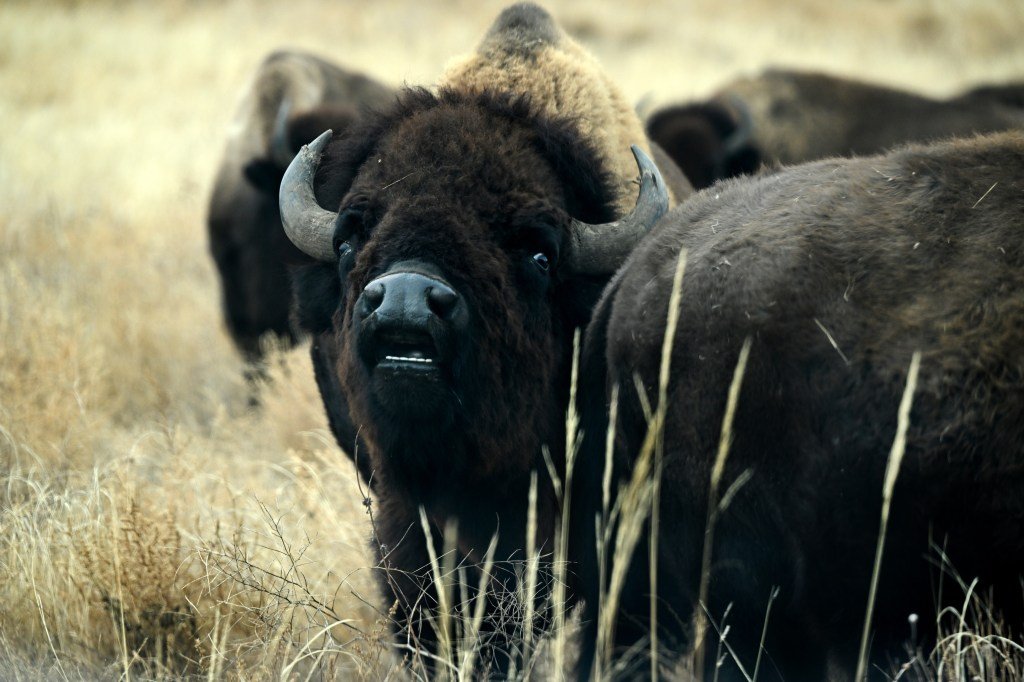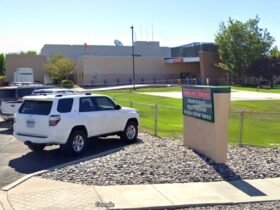Every so often, wild bison from one of Utah’s herds cross the invisible state border and wander into northwest Colorado — unknowingly putting their lives in danger.
When the bison cross over, they lose the protections Utah gives the species as a big-game animal. In Colorado, there are no repercussions for killing wild bison.
Such killings are rare in Colorado, but the state should protect the species because of its importance to Coloradans and Native American communities across the country, Sen. Jessie Danielson said. The Jefferson County Democrat is sponsoring a bill in the legislature that would make it illegal to kill bison here.
“This is a really important animal to the state of Colorado, our history, our cultural background,” Danielson said. “The Native community brought this forward because of the importance of the animal to their religion and culture.”
Senate Bill 53 would classify bison as big-game wildlife, which would regulate the killing of the native species. Like it is for elk and deer, the killing of wild bison would be legal only with a hunting permit approved by Colorado Parks and Wildlife.
Killing a bison without a permit would be considered poaching and punishable by a fine or imprisonment. The changes proposed in the bill would not apply to privately owned bison on ranches or preserves.
The bill passed out of the Senate Agriculture and Natural Resources Committee last week on a 4-3 vote. It is one of three pieces of legislation from the legislature’s American Indian Affairs Interim Study Committee, which convened for the first time last year.
Colorado Parks and Wildlife officials are aware of 12 incidents over the last 10 years in which wild bison were killed in Colorado, Andy Holland, the big game manager for CPW, said Thursday during a committee hearing for the bill. Wild bison that cross into Colorado generally come from the Book Cliffs herd across the Utah border, near Grand Junction.
About 130 animals make up the subherd closest to the Colorado border, he said.
Tens of millions of bison roamed the Great Plains and the West until the arrival of European American settlers, who systematically decimated the herds. By the early 1800s, bison no longer existed west of the Rocky Mountains or east of the Mississippi River and were slaughtered across the Great Plains, according to the U.S. Fish and Wildlife Service.
Settlers killed the bison to sell their skins, and the U.S. military used the mass slaughter of the buffalo as a way to weaken and undermine the Native American tribes that relied on the animal for food, shelter and spiritual needs.
By 1889, only a few hundred wild bison remained. The last wild bison in Colorado were killed in 1897 in South Park, according to CPW.
The federal government, states and tribal nations have since worked to grow and manage bison herds. Approximately 20,500 bison now live in conservation herds — like those that live in Denver’s Genesee Park in the foothills — and an additional 420,000 live in commercial herds, according to the Fish and Wildlife Service.
Native American leaders from multiple tribes who spoke in favor of the bill last week said bison — also called the American buffalo — should be welcomed back into Colorado and recognized as a survivor of genocide.
“We have a total annihilation of a species that we as Native people can relate to — because, essentially, they were trying to get rid of us and annihilate us,” said Teddy McCullough, a citizen of the Coyote Valley Band of Pomo Indians. “There is a total interconnectedness between who we are as Native people and who our cultures are and what happened to the bison.”
Buffalo are considered a family member in many tribes and remain an important part of many tribes’ traditions.
“These are more than just animals — they are kin, providers and the cornerstone of our very existence,” Southern Ute Tribe council member Andrew Gallegos said.
The ceremonies that use parts of the buffalo — like hides and bones — are not relics of the past but an active part of many tribes’ culture today, said Dustin Baird, who is Oglala Lakota.
“A buffalo hide is not just a blanket — it is a prayer and a reminder,” he said. “Its warmth wraps us in the lessons of the buffalo, teaching us how to be strong, patient and steadfast in our responsibilities to one another.”
The Associated Governments of Northwest Colorado opposed the bill, arguing that protections for bison could lead to an eventual herd becoming established in Colorado, which could impact the agricultural economy of the region.
“In northwest Colorado, where grazing and agriculture are one of our few economic drivers, we feel that added species protection for bison puts additional stress on existing limited resources for local ranchers and CPW,” said Richard Orf on behalf of the association of local governments.
Colorado Parks and Wildlife officials said Thursday that the agency supported the intent of the bill but it needed amendments. The agency wants lawmakers to extend the effective date of the bill to May 2026, to establish hunting license fees in case a bison hunting season eventually opens and to create costlier penalties for illegal poaching of the species.
The agency does not plan to open a hunting season for bison in the near future but wants hunting fees to be established now for efficiency, said Brian Dreher, CPW’s assistant director for the Terrestrial Wildlife Branch.
Other states in the Rocky Mountain West — including Utah, Montana, Arizona, New Mexico and Wyoming — have already adopted similar laws classifying wild bison as big game.
“Colorado is currently an outlier, despite our love for this creature,” said Annika Antholis, a campaign associate for Environment Colorado.
Stay up-to-date with Colorado Politics by signing up for our weekly newsletter, The Spot.













Leave a Reply